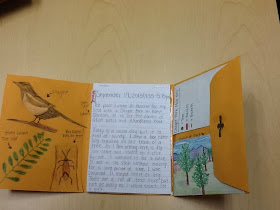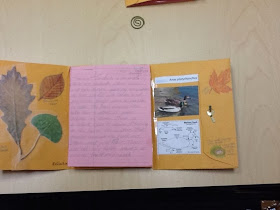 I had my class create small field journals out of envelopes. (See the end of this entry for directions on how to make the field journal)
I had my class create small field journals out of envelopes. (See the end of this entry for directions on how to make the field journal)
I then had them complete the following assignment:
Select
a plot of land, roughly the size of a football field. This will be your field site. You may select a field, meadow or even a
park. During the semester you will go
out into your selected plot of land and observe nature. Each time you go out you will write a descriptive
observation of something. You will also
collect small specimens and sketch pictures in your field journal. When possible, you will try to identify
species of trees, flowers, birds or insects.
Here
are a few required elements:
Introduction: In the beginning of your field journal give
an introduction to your site that includes:
·
Site,
name and location including map.
·
A
sketch, drawing or photograph of the site
Field
observation descriptions: At least five times during the semester you should go
out into your site and observe for a least 30 minutes. You will handwrite your observations. This is a field journal, do not go back home
and type them up. Include the date and
your observations. Each entry should be
at least 6 sentences long and include detailed descriptions. You may choose to describe birds you see or
plants or other evidence of nature: scat, feathers, animal tracks, seed pods,
etc. Notice little things: What are the
plants doing? Are any leaves changing color? What animals do you see or hear? What animal signs? How have these things changed since the last
visit?
Sketchings:
You must include at least three observation drawings or sketchings (in addition
to the picture of your site as a whole.)
Draw pictures of leaves, trees, flowers, etc. Try to determine the species and label them
accordingly. You can determine the
species once you return to your computer.
Use pencils or colored pencils for the observational drawings.
Specimens: Include pressed leaves, feathers, flowers or
other small specimens. Your finished
field journal should have at least three specimens. Try to identify them and label them. Be
sensitive when collecting and obey all laws regarding the picking of live
vegetation. Items too large or awkward
to collect and include in your field journal may be photographed and the photos
can be added to your field journal.
Examples of items too large to add to your notebook might be a nest,
animal scat, animal tracks, animal remains, etc. You still are required to have some actual
specimens from nature. Hint: Clear packing tape seals the specimen down nicely and seems to preserve it a little.
Today I am assessing the results and they are simply wonderful!
Look at the detailed map the above student made!
This student added a lift the flap in order to have more room for display.
Note that the clear packing tape really seals down the specimens.
For more examples: field journal album
This is a great activity to get students outside in nature and observing in a scientific way! Many of my students were amazed at how much nature was right outside their door. This could also be done in a school yard as a more directed activity. The activity can easily be adjusted to what your grade level is studying: such as animal and plant adaptations or the weather.
Directions for Creating the Envelope Journal:
1.
Start with a manila envelope. I like small ones so that the journal will be pocket sized, but you can use any size. Fold in half with the flap going towards the center.
2.
On the side opposite of the flap, shave both sides from the bottom to the crease.
3.
Inserting the scissors inside the side you just opened by shaving, cut the TOP page only of the center seam.
4.
Now the flap opens up away from the center.
5.
Add paper for writing. Seal the bottom of the envelope down with a piece of tape, so that you can use this section for collecting specimens. That is it!
Teacher Tip: Clear packing tape seems to work well for preserving small specimens, such as leaves. Seal them completely to the paper so that they are not exposed to air. See example below.
Album cover ideas...





















